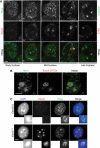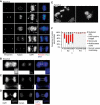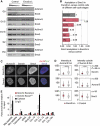Cohesin acetyltransferase Esco2 is a cell viability factor and is required for cohesion in pericentric heterochromatin
- PMID: 22101327
- PMCID: PMC3252581
- DOI: 10.1038/emboj.2011.381
Cohesin acetyltransferase Esco2 is a cell viability factor and is required for cohesion in pericentric heterochromatin
Abstract
Sister chromatid cohesion, mediated by cohesin and regulated by Sororin, is essential for chromosome segregation. In mammalian cells, cohesion establishment and Sororin recruitment to chromatin-bound cohesin depends on the acetyltransferases Esco1 and Esco2. Mutations in Esco2 cause Roberts syndrome, a developmental disease in which mitotic chromosomes have a 'railroad' track morphology. Here, we show that Esco2 deficiency leads to termination of mouse development at pre- and post-implantation stages, indicating that Esco2 functions non-redundantly with Esco1. Esco2 is transiently expressed during S-phase when it localizes to pericentric heterochromatin (PCH). In interphase, Esco2 depletion leads to a reduction in cohesin acetylation and Sororin recruitment to chromatin. In early mitosis, Esco2 deficiency causes changes in the chromosomal localization of cohesin and its protector Sgo1. Our results suggest that Esco2 is needed for cohesin acetylation in PCH and that this modification is required for the proper distribution of cohesin on mitotic chromosomes and for centromeric cohesion.
Conflict of interest statement
The authors declare that they have no conflict of interest
Figures







Similar articles
-
Esco1 Acetylates Cohesin via a Mechanism Different from That of Esco2.Curr Biol. 2015 Jun 29;25(13):1694-706. doi: 10.1016/j.cub.2015.05.017. Epub 2015 Jun 4. Curr Biol. 2015. PMID: 26051894
-
The replicative helicase MCM recruits cohesin acetyltransferase ESCO2 to mediate centromeric sister chromatid cohesion.EMBO J. 2018 Aug 1;37(15):e97150. doi: 10.15252/embj.201797150. Epub 2018 Jun 21. EMBO J. 2018. PMID: 29930102 Free PMC article.
-
The non-redundant function of cohesin acetyltransferase Esco2: some answers and new questions.Nucleus. 2012 Jul 1;3(4):330-4. doi: 10.4161/nucl.20440. Epub 2012 May 22. Nucleus. 2012. PMID: 22614755 Review.
-
Esco1 and Esco2 regulate distinct cohesin functions during cell cycle progression.Proc Natl Acad Sci U S A. 2017 Sep 12;114(37):9906-9911. doi: 10.1073/pnas.1708291114. Epub 2017 Aug 28. Proc Natl Acad Sci U S A. 2017. PMID: 28847955 Free PMC article.
-
The expanding phenotypes of cohesinopathies: one ring to rule them all!Cell Cycle. 2019 Nov;18(21):2828-2848. doi: 10.1080/15384101.2019.1658476. Epub 2019 Sep 13. Cell Cycle. 2019. PMID: 31516082 Free PMC article. Review.
Cited by
-
Alternative catalytic residues in the active site of Esco acetyltransferases.Sci Rep. 2020 Jun 17;10(1):9828. doi: 10.1038/s41598-020-66795-z. Sci Rep. 2020. PMID: 32555289 Free PMC article.
-
Akirin2 is essential for the formation of the cerebral cortex.Neural Dev. 2016 Nov 21;11(1):21. doi: 10.1186/s13064-016-0076-8. Neural Dev. 2016. PMID: 27871306 Free PMC article.
-
Age-related aneuploidy through cohesion exhaustion.EMBO Rep. 2012 Jun 1;13(6):539-46. doi: 10.1038/embor.2012.54. EMBO Rep. 2012. PMID: 22565322 Free PMC article. Review.
-
Stimulation of mTORC1 with L-leucine rescues defects associated with Roberts syndrome.PLoS Genet. 2013;9(10):e1003857. doi: 10.1371/journal.pgen.1003857. Epub 2013 Oct 3. PLoS Genet. 2013. PMID: 24098154 Free PMC article.
-
Meiosis-specific cohesin component, Stag3 is essential for maintaining centromere chromatid cohesion, and required for DNA repair and synapsis between homologous chromosomes.PLoS Genet. 2014 Jul 3;10(7):e1004413. doi: 10.1371/journal.pgen.1004413. eCollection 2014 Jul. PLoS Genet. 2014. PMID: 24992337 Free PMC article.
References
-
- Ben-Shahar TR, Heeger S, Lehane C, East P, Flynn H, Skehel M, Uhlmann F (2008) Eco1-dependent cohesin acetylation during establishment of sister chromatid cohesion. Science 321: 563–566 - PubMed
-
- Gordillo M, Vega H, Trainer AH, Hou F, Sakai N, Luque R, Kayserili H, Basaran S, Skovby F, Hennekam RCM, Uzielli MLG, Schnur RE, Manouvrier S, Chang S, Blair E, Hurst JA, Forzano F, Meins M, Simola KOJ, Raas-Rothschild A et al. (2008) The molecular mechanism underlying Roberts syndrome involves loss of ESCO2 acetyltransferase activity. Hum Mol Genet 17: 2172–2180 - PubMed
Publication types
MeSH terms
Substances
LinkOut - more resources
Full Text Sources
Medical
Molecular Biology Databases
Research Materials

